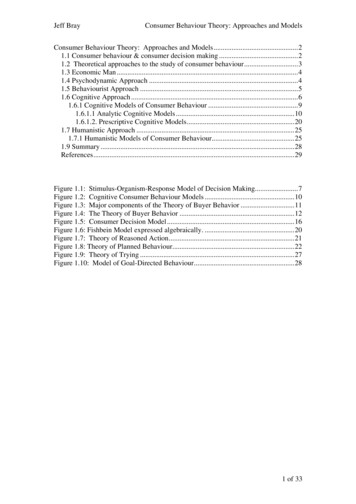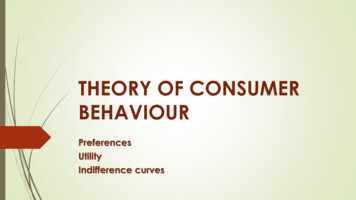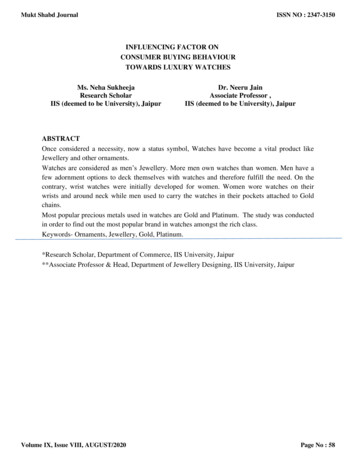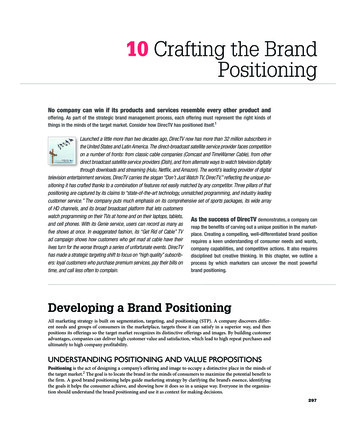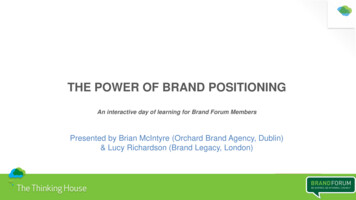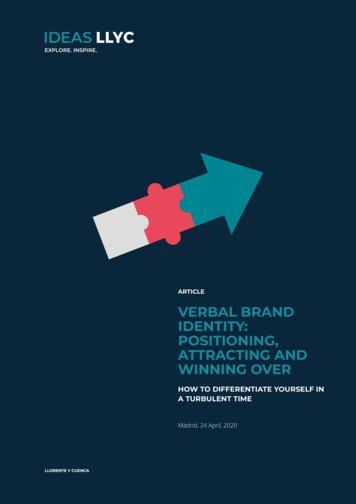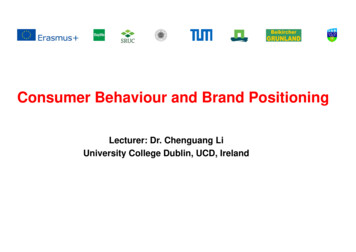
Transcription
Consumer Behaviour and Brand PositioningLecturer: Dr. Chenguang LiUniversity College Dublin, UCD, Ireland
CASE STUDY—RETAIL BRAND POSITIONING
Food Retailing Industry Average spending – 5,200 annually 2.1 trips weekly (weekly before, now 40% stock-up trips;60% consumer fill-in trips)http://wsm.wsu.edu/researcher/wsmaug11 billions.pdf
Consumer trends#1--Dwindling of consumer loyalty– Savvy consumer searching for best deals– Growth of warehouse and superstores--- bulk-buying budgetshopper– Low priced promotions --- specific supermarkets, discountstores(dollar store)– Shopping trip (weekly before, now 40% stock-up trips; 60%consumer fill-in trips)
Consumer trends#2—Changing attitude to Private label– 2005 14%--- 2010, 17%– Higher margin– Store brand– Retailer effort on change of quality perception
Consumer trends#3—Health Conscious– Whole foods– Health and organic departments– Product selections
A quick review of the retail industrySpecialtygrocery retailersWarehouse clubLow‐end channels(drug stores)Dollar store chainsSupermarket1950sSupercenter1980sGas Station mini mart& convenient stores2000sTime
Brand Positioning Factors Time (location)PriceVariety (assortment)Quality (product, store environment, service, etc.)
Supermarket Eg. Safeway (Tesco, Supervalu)
Supermarket Eg. Safeway (Tesco, Supervalu)Size: 46,800Assortment: 50,000Weekly sales: 485,000Service area: 1-3 milesProfit margins: 1.5-2.5%
Selection In-store bakeriesSeafoodMeatCold cutsProducePackaged foodsCleaning productsHealth and beauty aidsothersONE‐STOP shoppingConvenience
Supercenter Eg. Walmart. Target
Supercenter Eg. Walmart. Target70,000 sq ft (of 170,000)Large, free-standing buildings in suburban areasOne-stop shopping, multiple needsLower pricesLonger travel times (5-10 miles away)
Warehouse Clubs Eg. Costco, Sam’s Club
Warehouse Clubs Eg. Costco, Sam’s ClubLike airport hangars than supermarketsManufacturers’ packing cratesBulk-packedGray industrial shelving (hence the name warehouse club)Limited brand (one brand soup, one brand of butter )Low price (20% lower)Similar profitsConsumers?
Dollars stores Eg. Dollar general, dollar tree, family dollars
Dollars stores Eg. Dollar general, dollar tree, family dollarsPackaged food, housewares, clothing, seasonal items, etc.Low price ( 1 )Size (7,000 tp 10,000 sq ft)Average shopping ticket ( 7- 10)Limited ranges of food items (what? And why?)Store environment ( )Net profit margin (?)Customers?
Limited selection Stores Eg. Trader Joe’s
Limited selection Stores Eg. Trader Joe’sSize: smaller; 8,000-12,000Assortment: 1,500Brand: private labels (85%); imported and specialty foodproduce, baked goods, but no in-house meat or bakeries
Lower-end Limited selection stores Eg. Aldi
Lower-end Limited selection stores Aldi, LidlLean operating modelPrivate model (95%)Selection (1,400 items)Discounted pricesStore environment (clean, bright, pleasant)Packaging—simple
3rd largest town in Ohio Population 2 million In 2010, median householdincome – 52,000 (11.6% higher than the state average,slightly higher than the national median) Population growth 11% (2000 to 2009) ‐‐‐‐9% national Unemployment rate 8.5% (9.8%national)
Choice Dilemma Price cut? Value-added?What would you suggest?
Brand is everywhere in our livesLogoImagePromiseexperiencePerception
Why is branding important?competitive advantages. high level of consumer brand awareness and loyalty.more leverage in bargaining with resellers.more easily launch line and brand extensions.some defense against fierce price competition. Most importantly, a powerful brand forms the basis for buildingstrong and profitable customer relationships.
Why is branding important?A powerful brand has high brand equity.Brand equity Perception or desire about a brand in meeting thepromised benefits. a measure of the brand’s ability to capture consumerpreference and loyalty.A brand with high brand equity is a very valuable asset.
The World's Most Valuable Brands, rank header:brandValue sortreverse:true
Benefits.Brand equity Perception or desire about a brand in meetingthe promised benefits.
BrandingBranding is defining, promising, and delivering a unique experienceconsistently. How are they different?Why are they different?Who are the consumers?What does the brand mean to consumers?How was the brand communicated to consumers?Benefits: Functional Emotional Social Others
Customer-Based Brand Equity PyramidSource: Keller, Kevin Lane, Strategic Brand Management: Building, Measuring, and Managing Brand Equity, Prentice Hall, 2012, 4th edition31
Increasing consumer orientation
Model of Consumer BehaviorThe environmentBuyer’s Black BoxBuyer’s responsesProduct ther:Buyer’s decision processBrand s characteristicsPurchase timingPurchase amountCompany relationship
Buyer’s decision processStep 1: Recognize a problemStep 2: Search for informationStep 3: Evaluate AlternativesStep 4: Choose THE ProductStep 5: Postpurchase EvaluationHOW?
Lancaster’s consumer theoryAlso known as “product attributes model”, assumes thatconsumer choice is based on the characteristics ( orattributes) of a brand. The consumer maximizes his utilitybased on the bundle of these attributes existing in the brandthat he chooses within a budget constraint.Attribute YKelvin Lancaster, 1924‐1999ALancaster, K. J. (1966). A new approach to consumertheory. Journal of political economy, 74(2), 132‐157.BLinking consumer choices with product attributesGwin, C. F., & Gwin, C. R. (2003). Product attributes model: A toolfor evaluating brand positioning. Journal of Marketing Theory andpractice, 11(2), 30‐42CAttribute x
Suppose you want to rent a house
M2Your choice is based on thebundle of productattributes that maximizesthe consumer's utility,subject to budge constraint.ABClocation
TasteThe product attributes model can be used toanalyze a brand's positioning and its effect onconsumer choice.ASTRATEGIC IMPLICATIONS FOR BRANDPOSITIONINGB Market Segmentation/Target Market Positioning New Product Changes in Existing Product Promotion (Change Perceptions)CEg. processed meat, functional food, whey, super milk etc.Health
What can affect consumer preference and choicesCultural:Culture; Subculture; Social classSocial:Reference groups; Family; Role and statusPersonal:Age; occupation; lifestyle; personalityPsychological:Motivation; ,Perception;Learning; Beliefs &attitudeBuyerChicken, spaghetti sauceOpinion leader
Consumer Lifestyle Lifestyles reflect a pattern of living Consumers’ lifestyles are measured and describedaccording to AIOs– activities– interests– opinions
Six major lifestyle trends ‐‐ 2014 fluid lives, simple pleasure, response living, quest for health and wellness, consumers in control, keeping it real.Source: Bord Bia (Irish Food Board) Consumer lifestyle Trends report (2014 �%20June%202014.pdf
Market examples ‐‐ Busy LivesVigoo freshly squeezed orange, China
Market examples – Health and Wellbeing
Market examples – Keeping it realDIY butchery courses, UK, US, CA
Personal Factors Affecting Consumer Behavior Personality: the unique psychological characteristicsthat lead to consistent and lasting responses to theconsumer’s environment
What can affect consumer preference and choicesCultural:Culture; Subculture; Social classSocial:Reference groups; Family; Role and statusPersonal:Age; occupation; lifestyle; personalityPsychological:Motivation; ,Perception;Learning; Beliefs &attitudeBuyer
MotivationA motive is a need that is sufficiently pressing to direct theperson to seek satisfactionMotivation research refers to qualitative research designed toprobe consumers’ hidden, subconscious motivations
Maslow’s Hierarchy of NeedsCopyright 2014 by Pearson Education
The OLD starvation experimentA clinical study performed at the University of Minnesota between November 19, 1944 andDecember 20, 1945. The investigation was designed to determine the physiological andpsychological effects of severe and prolonged dietary restriction and the effectiveness of dietaryrehabilitation strategies
NEW economic study of scarcityScarcity‐‐Why Having Too Little Means So MuchSendhil Mullainathan,a professor of economics at Harvard University, is a recipientof a MacArthur Foundation “genius grant” and conductsresearch on development economics, behavioral economics,and corporate finance. He lives in Cambridge, Massachusetts. Top of mind, motivation, and efficiencyDifferent Stage of needs? China ‐‐‐ food safety Ireland, Origin Green‐‐‐ sustainability
The power of HabitA cue is a trigger. It is the stimulus or experience that starts the cycle of a habit.
Rethinking Product AttributesStories about Febreze Toothpaste
Perception Perception:– Process by which we select, organize, and interpret information from outsideworld Three factors are necessary for perception to occur– Exposure: capable of registering a stimulus– Attention: mental processing activity– Interpretation: assigning meaning to a stimulus5 55
Consumer PerceptionExamples Blind Test for Coke Coke with namesSelective attention is the tendency for people to screen out most of the information to which they areexposedSelective distortion is the tendency for people to interpret information in a way that will support whatthey already believeSelective retention is the tendency to remember good points made about a brand they favor and forgetgood points about competing brands
The perceptual processAn overview of the perceptual process
Are Consumers (We) Rational?Notable for his work on the psychology of judgment and decision‐making, as well as behavioral economicsAwarded the 2002 Nobel Prize in Economic Sciences."System 1" is fast, instinctive and emotional;"System 2" is slower, more deliberative, and more logical.His empirical findings challenge the assumption of human rationalityprevailing in modern economic theory.In 2014, The Economist listed him as the 15th most influentialeconomics in the world.Source: http://en.wikipedia.org/wiki/Thinking, Fast and SlowDaniel KahnemanThinking, Fast and SlowAn interview with Kahneman:https://www.youtube.com/watch?v PirFrDVRBo4
The old classicmagic number“9”
THE MAGIC #9 --- DOES IT MAKE SENSE? 35 vs 39Was 60, now only 45!Was 60, now only 49!Effects of 9 Price Endings on Retail Sales: Evidence from Field 23%2FA%3A1023581927405
PRICE AS A SIGNAL FOR QUALITY Price can act as a signal for quality, Especially when prior experience is limited But consumer’s choice is context dependent 299 or 300
Small Difference can make big DifferenceScenario 1: 63vs 63Scenario 2: 62vs 64Source: Yale research published on Psychological ScienceAdding Small Differences Can Increase Similarity and Choice
Small Difference can make big Difference% made a purchase2 gumsDifferent price2 gumssame price77%46%Slightly different prices, more likely to buy
Reference PricingReference price is what buyers carry in their minds and refer to when looking ata given product.Different consumers may have different reference price for the same product.In some cases, marketers try to influence consumers’ expectations of what aproduct should cost when they use reference‐pricing strategiesNationalBrand
Fairness in pricing? 1.80 2.5020%80%See William Poundstone’s book: Priceless: The Myth of Fair Value
Fairness in pricing? 1.60 1.80 2.500%80%20%
Fairness in pricing? 1.80 2.50 3.405%85%10%
WHY?Why does reference pricing works?Why is it easier for people to pay for a product whenthere is another more expensive product next to it?How do you feel when you pay money to buy stuff?
Spending Can Cause REAL PainKnutson, Brian, Scott Rick, G. Elliott Wimmer, Drazen Prelec, and George Loewenstein (2007), “Neural Predictors of Pur‐chases,” Neuron, 53 (January), 147–56“prices do not deter spending purely through thoughts of foregone pleasures, as assumed by standard economic theory, butalso through immediate pain.”‐‐Scott Rick
Three Types Of BuyersCharacterized by the “pain” they experience when purchasingsomething Ouch, it hurts! ‐‐‐”tightwads” (24%) Regular pain ‐‐‐ unconflicted (61%) Not much‐‐‐ spendthrift ( 15%)Rick, Scott I., Cynthia E. Cryder, and George Loewenstein. "Tightwads and spendthrifts." Journal ofConsumer Research 34.6 (2008): 767‐782.
Reduce The Pain--Reframing The Value Reframing the value – make it looks smaller 84/month vs 1,000/yearOr maybe this only works for those who can’t do themath?
Reduce The Pain‐‐BundlingTo reduce the pain points Individual purchases create individual pain points Customers prefer to complete purchase in one time thanseparately upgrade car packages all at once Compute and accessories
Reduce The Pain—Use the right WordingConvert consumer without changing the priceEg: “a 5 fee” to “a small 5 fee”Effect 20%
Experiment About Framing (Context)Experiment:Would you opt for surgery if Scenario 1: the “survival” rate is 90 percent,Scenario 2: the “mortality” rate is 10 percent.The first scenario increased acceptance, even though thesituation was no different.
Time, Feeling, Personal Connection “How we spend our time says so much more about who we are than does how we spendour money.”‐‐‐Cassie Mogilner"Because a person's experience with a product tends to foster feelings of pe
Most importantly, a powerful brand forms the basis for building strong and profitable customer relationships. . Model of Consumer Behavior Other: Economics technological social cultural Marketing stimuli: Product Price Place Promotion Buyer’s decision process Buyer’s characteristics The environment Buyer’s Black Box Product choice Brand choice Purchase timing Purchase amount .

